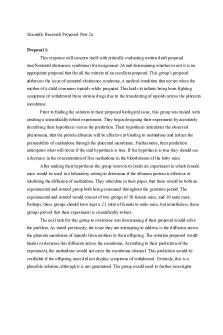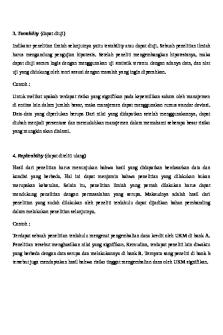Scientific Research Proposal Part 2a PDF

| Title | Scientific Research Proposal Part 2a |
|---|---|
| Course | Intro To Cell & Molecular Biol |
| Institution | Binghamton University |
| Pages | 4 |
| File Size | 65.1 KB |
| File Type | |
| Total Downloads | 44 |
| Total Views | 162 |
Summary
Project...
Description
Scientific Research Proposal: Part 2a
Proposal 1: This response will concern itself with critically evaluating written draft proposal one(Neonatal abstinence syndrome) for assignment 2A and determining whether or not it is an appropriate proposal that fits all the criteria of an excellent proposal. This group's proposal addresses the issue of neonatal abstinence syndrome, a medical condition that occurs when the mother of a child consumes opioids while pregnant. This leads to infants being born fighting symptoms of withdrawal from various drugs due to the transferring of opioids across the placenta membrane. Prior to finding the solution to their proposed biological issue, this group was tasked with creating a scientifically robust experiment. They begin designing their experiment by accurately describing their hypothesis versus the prediction. Their hypothesis articulates the observed phenomena, that the protein albumin will be effective at binding to methadone and reduce the permeability of methadone through the placental membrane. Furthermore, their prediction anticipates what will occur if the said hypothesis is true. If the hypothesis is true they should see a decrease in the concentration of free methadone in the bloodstream of the baby mice. After making their hypothesis the group went on to create an experiment in which female mice would be used in a laboratory setting to determine if the albumin protein is effective at inhibiting the diffusion of methadone. They articulate in their paper, that there would be both an experimental and control group both being examined throughout the gestation period. The experimental and control would consist of two groups of 50 female mice, and 10 male mice. Perhaps, these groups should have kept a 2:1 ratio of female to male mice, but nonetheless, these groups proved that their experiment is scientifically robust. The next task for this group to overcome was determining if their proposal would solve the problem. As stated previously, the issue they are attempting to address is the diffusion across the placenta membrane of opioids from mothers to their offspring. The solution proposed would hinder or decrease this diffusion across the membrane. According to their prediction of the experiment, the methadone would not cross the membrane channel. This prediction would be verifiable if the offspring mice did not display symptoms of withdrawal. Certainly, this is a plausible solution, although it is not guaranteed. The group would need to further investigate
whether or not albumin was interfering with other nutrients being able to travel across the membrane. Nonetheless, this is a step in the right direction for further research on an epidemic that is affecting thousands of families in America. Looking primarily at the experiment, the group demonstrates clear knowledge of a well thought out scientific experiment. This is shown through their attention to detail of how many mice would be needed for the experiment and how the opioid methadone or saline solution would be administered. Due to the efforts put into this small trial, if it were to be completed on a larger scale they have already laid a clear and strong building block. Also, if other scientists wanted to conduct their own experiments, they would have concise knowledge from this group. Although, they would need a substantial amount of funding in order to work in a large lab, also to obtain the supplies needed such as the mice itself, methadone, tools for the administration, etc. One of the main arguments this group proposes is that opioids are harmful, not only to the mothers ingesting it but to the offspring as well. This entire experiment relies on the administration of this harmful substance into innocent mice, that in any other ordinary case would not have been introduced to opioids. Not only this but even opioids in small doses can be addicting, this pegs the question of what will happen to the mice? Once the research is gathered, what is next? This at first may seem unethical, but mice are often bred just for scientific purposes, and we must take into consideration that this trial of mice may be the next solution to ending neonatal abstinence syndrome. In this scenario, the ends justify the means, and this experiment is indeed ethical. Furthermore, this group demonstrates adequate understanding of this assignment meeting all criteria needed of an excellent proposal, thus creating an experiment that directly addresses the biological issue of neonatal abstinence syndrome.
Proposal 2: For written draft proposal two regarding microplastic pollution in the ocean, the experiment is not a well written proposal. The experiment the group designed was not scientifically robust. The prediction the group made should have been based on the hypothesis, but both the hypothesis and the prediction are too vague. For the hypothesis, the group states that “If compostable/edible casing were made equal in price and accessibility as plastic water bottles and straws, there will be an effect on the amount of microplastics polluting the water.” Rather
than saying that there will be an effect, the group should specify that there will be a decrease in the amount of microplastics. Also, for the prediction, the group should be more specific about experiment details. There should be measurements, length of time for experimentation, etc. The methods section is described in a way that anyone could recreate the experiment, it is just not feasible. This is not so much an experiment with a biological solution than it is a legislative solution to the issue. It is unreasonable and unrealistic for the solution to be to remove all plastic straws and bottles from the market. Although anyone could recreate this “experiment”, the group does not specify what makes the materials of the water pods and straws biodegradable. A better experiment would be to test different materials for their biodegradability compared to plastic. For the current “experiment” described, there are no variables to the experiment. That means that there are no control or experimental groups. Since the experiment doesn’t offer a biological solution, the group is not testing anything. Usually, in experiments, there should be an experimental group in which a specific variable is being tested and at least a negative control group where the variable is excluded. This is not an experiment that follows the scientific experimental design. This also means that this is not a controlled experiment because the methods used don’t have two distinct groups where the conditions are set to be the same other than the variable. To improve this portion, the group needs to design an experiment that is testable in a lab environment. For example, they can test enzymes that can break down plastic. In this proposed solution, the experimental group would include the enzymes that can break down plastic and the negative control group would be the group that does not include the enzyme. Through this, the group can measure the amount of microplastic still present with each group and compare the effects of the enzyme. There is no sample size described in the group’s proposal since essentially there is no experiment so it’s hard to say whether or not the sample size is feasible or not. Another thing to note is that there was only one scientific source used from the Ocean Conservancy’s 2017 Coastal Cleanup Report. The group did not properly format the in-text citation and they also didn’t have a works cited page for all the sources that they used. Since there was only one scientific source used, it seems that the group didn’t find any scientific papers that relate to their proposed solution. This may be an incentive to change the proposed solution to a more biological approach. Like mentioned before, the experiment is not feasible. The proposal for the experiment is
vague and seems to be fairly large-scale. Also, the proposed solutions do not solve the problem of microplastic pollution in the ocean. The proposed solutions are to have production factories produce biodegradable water pods and to remove and properly recycle plastics that are currently on the market. However, the group describes human error as a contributing factor to the problem. With the number of plastic bottles and straws currently in the market, “properly recycling” all the plastic is not a feasible task if human error is a factor. Also, the proposed solutions are not biological approaches to the issue. The group proposes to incentivize companies and to utilize social media to encourage the use of plastic alternatives. While this may help in retrospect, this is not a biological approach. Instead, they should propose a solution such as enzyme breakdown. Also, this is yet another overly simplistic solution. They fail to realize the fact that there are already a lot of social media promotions of alternatives to plastic bottles and straws and yet there hasn’t been a major effect on microplastic pollution....
Similar Free PDFs

Assignment 2a - Market Research
- 8 Pages

NS50 - Scientific Proposal
- 11 Pages

Research Proposal
- 3 Pages

Research Proposal
- 5 Pages

Research proposal
- 12 Pages

Research Proposal
- 15 Pages

Research proposal template APA
- 8 Pages

Research Proposal PO370 X
- 4 Pages

Atu Research Proposal - reserach
- 37 Pages

Research proposal complete
- 50 Pages
Popular Institutions
- Tinajero National High School - Annex
- Politeknik Caltex Riau
- Yokohama City University
- SGT University
- University of Al-Qadisiyah
- Divine Word College of Vigan
- Techniek College Rotterdam
- Universidade de Santiago
- Universiti Teknologi MARA Cawangan Johor Kampus Pasir Gudang
- Poltekkes Kemenkes Yogyakarta
- Baguio City National High School
- Colegio san marcos
- preparatoria uno
- Centro de Bachillerato Tecnológico Industrial y de Servicios No. 107
- Dalian Maritime University
- Quang Trung Secondary School
- Colegio Tecnológico en Informática
- Corporación Regional de Educación Superior
- Grupo CEDVA
- Dar Al Uloom University
- Centro de Estudios Preuniversitarios de la Universidad Nacional de Ingeniería
- 上智大学
- Aakash International School, Nuna Majara
- San Felipe Neri Catholic School
- Kang Chiao International School - New Taipei City
- Misamis Occidental National High School
- Institución Educativa Escuela Normal Juan Ladrilleros
- Kolehiyo ng Pantukan
- Batanes State College
- Instituto Continental
- Sekolah Menengah Kejuruan Kesehatan Kaltara (Tarakan)
- Colegio de La Inmaculada Concepcion - Cebu





